Water purification from a well: an overview of the best and most effective ways
The well is one of the most affordable ways to supply water to a suburban area. It provides life-giving moisture for the natural needs of households, their household needs and watering plants on the site. Therefore, the water in it must be free from all kinds of impurities. It is necessary to get rid of pollution immediately. Do you agree?
From the article we have proposed, you will learn what stages include the treatment of water from a well, and also whether it can be carried out on your own. We will tell you by what signs water pollution is determined. We present in detail the effective ways to eliminate mineral and organic inclusions.
The content of the article:
The main causes of well water pollution
The opinion that well water is a priori clean is mistaken. The depth of this water source is not so great. In groundwater, which feeds the well, impurities are often present in dissolved or suspended state.
Various types of bacteria often live in the tip, which multiply, create colonies and decompose over time to form hydrogen sulfide compounds. Such compounds give the water an unpleasant odor and make it toxic, and therefore dangerous to human health.
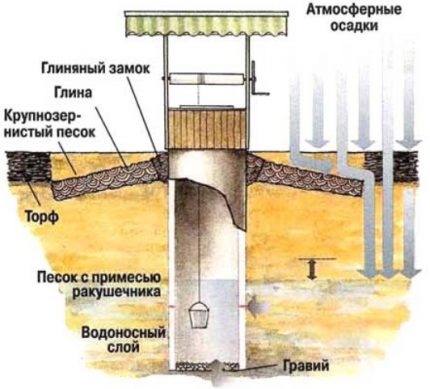
The causes of water pollution are conditionally divided into two types:
- Natural phenomena. These may be changes in the aquifers supplying the source, or seasonal phenomena. For example: getting into a source of organic matter, sunlight ...
- Problems provoked by a person. They arise in case of violation of the installation technology of the structure and errors during its operation.For example: the proximity of septic tanks, depressurization of joints, corrosion of metal elements ...
When arranging a hydraulic structure, it is important to monitor the renewal of water. So, with an irregular fence, it will stagnate and become cloudy. If the head of the source is open, then leaves and branches, insects and rodents can freely enter it.
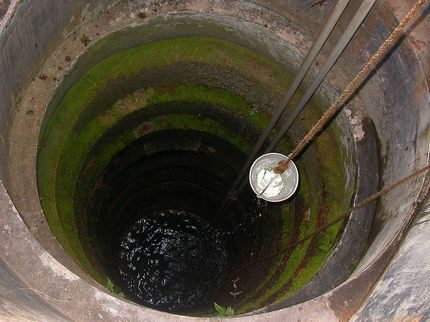
If the well is installed on a quicksand, then there is a high probability of the presence in the water of an increased content of colloidal impurities, organic and chemical substances. All these processes must be monitored and eliminated in time.
You can read all about the causes of turbidity and yellowing of well water in next article.
The main signs of water pollution
Studies of water from a well should be carried out annually, since its composition in an underground source, depending on seasonal changes and other external factors, can constantly change.
This is especially important if the source is used only in the summer. A number of signs will indicate the need for water treatment from the well.
How to take water from a well and pass a sample for analysis is detailed in the article we submitted.
Turbidity and precipitation
The opacity of the water indicates that too many silty fine particles and suspended dusty sand grains have accumulated inside the walls of the structure. This happens if the well rings lose their tightness due to erosion of the joints or when the elements are displaced relative to each other.
A clear sign of a violation of the tightness of the walls of the structure is the turbidity of the water after heavy rainfall. To eliminate the drawback helps the mechanical cleaning of the mine, supplemented by work on sealing joints and sealing joints.
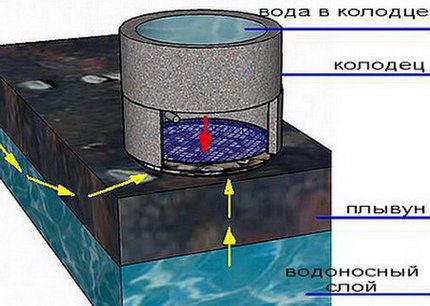
The appearance of an oil film over the water surface indicates the presence of petroleum products. This may occur due to depressurization of the mine. Or for the banal reason of improper observance of cleanliness during the operation of a hydraulic structure.
Natural color change
The shade of water in the well depends on the type of pollution. A change in color to green indicates the "bloom" of water. The reason for this may be direct sunlight in the mine.
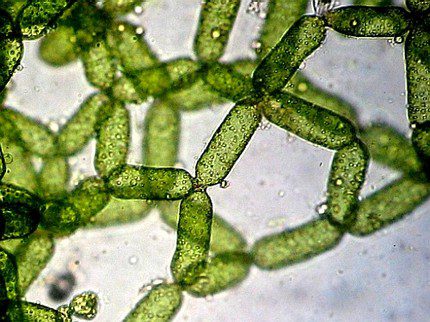
The problem is solved by disinfecting water using chemicals and then installing carbon filters.
Brown and yellow shades indicate that the water contains an increased iron content. Disinfection in this case is not effective. Only the arrangement of the water treatment system and the installation of additional filters will help to solve the problem.
Water acquires a black color due to organic pollution, which in the process of decomposition and decay infects it. To eliminate decaying organics, simple source disinfection no longer do.To get water that can be consumed, you will have to perform multi-stage cleaning.
Strange odor
Clay or earthy odor is due to the presence in the liquid of organic natural compounds such as 2-methylisoborneol and geosmin. They are formed during the life of soil bacteria and blue-green algae present in the water.
Eliminate the cause of mechanical cleaning of the building, followed by the arrangement of household reverse osmosis and the installation of filters equipped with activated carbon.
The smell of rotten eggs has water, in which sulfuric bacteria are present. They produce hydrogen sulfide.
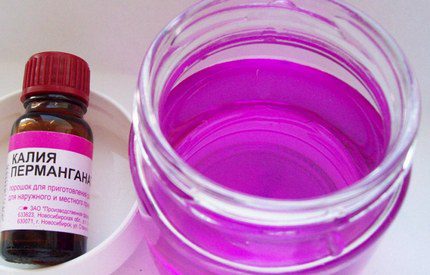
The smell of phenol and other unnatural aromas indicate that sewage and other products of human activity most likely entered the well shaft through underground aquifers. The problem can be solved by carrying out mechanical cleaning and installing a carbon filter.
Unusual taste of water
The brackish taste appears due to the high salt content: NaSO4, NaCl, MgSO4. You can remove it by performing additional post-treatment of water, passing it through household reverse osmosis.
A metallic taste indicates the presence of iron in water. Iron removal methods help to correct the situation. For example, the installation of a compressor that will saturate water with oxygen, a circulation pump and a de-ironing filter.
The sour taste of water, which has a blue-green hue, indicates a high content of carbon dioxide. This phenomenon occurs due to the reaction of water in contact with copper and bronze elements of the system.
Increased rigidity indicates the presence of calcium and magnesium salts in the liquid. Stiffness is not a constant value. It fluctuates depending on the season and reaches its peak in the summer.
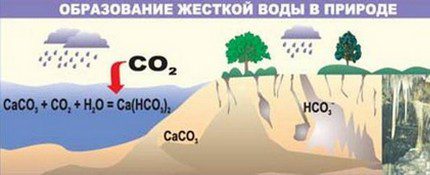
You can correct the situation by installing softening systems. Reagent and non-reagent filters of complex purification are able to demineralize and soften water.
Well water quality analysis
The listed “symptoms” indicate serious water pollution. And until it is cleaned, it is not recommended to operate the structure. To find out the cause of contamination and find the optimal solution for its elimination, it is necessary to take water samples and submit them for analysis.
The sequence of actions when taking fluid for research:
- A plastic or glass container with a volume of 1.5 liters is thoroughly washed with running water without using detergents. A plastic bottle from under mineral or distilled water is perfect for sampling.
- The container is gradually filled with water so that excessive oxygen does not form in the bottle from excessive pressure. If an automatic water supply system is established from the well, the water from the tap must first be drained, and then, at low pressure, fill the bottle to the neck.
- The filled container is tightly closed and wrapped in a dark plastic bag.
- Within three hours from the moment of sampling, the container with liquid is delivered to the laboratory.
Keep in mind that after two days from the moment of fluid intake, the results will already be unreliable.
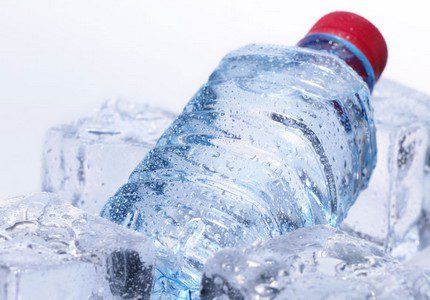
It is not possible to independently perform a water quality analysis. Obtaining accurate results cannot be achieved without the use of special equipment.
Research of this kind is carried out by:
- sanitary epidemiological station;
- state laboratories at geodetic centers;
- licensed private centers;
- accredited laboratories of Rospotrebnadzor.
The price of the service depends on the type of analysis. It can be shortened, focused on the identification of a certain group of substances, or complete, including chemical and microbiological research.
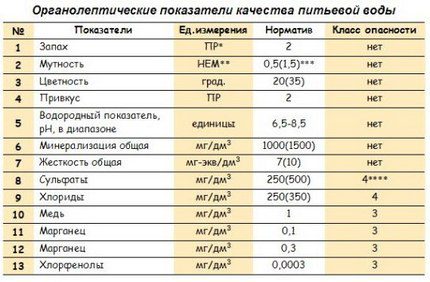
The results are entered into the protocol, which indicate the permissible percentage of impurities and substances in accordance with applicable sanitary standards. An opinion on the suitability of water and the presence of potentially harmful microorganisms and substances to it will be attached to the protocol.
At the request of the customer, specialists can also give recommendations on how best to purify water in a particular well and which filtration systems to apply in the future.
Effective Cleaning Methods
If the results of the study showed that the fears are not unfounded and the water contains impurities that are harmful to health, the situation should be corrected as soon as possible.
The choice of method depends on the cause of contamination. If garbage has accumulated inside the structure, and mucus has formed on the walls, it is worth using the mechanical method when cleaning the structure.
Shaft cleaning
The method involves cleaning the walls and bottom of the hydraulic structure by washing or scraping off accumulated layers. Mechanical cleaning It is better to perform in late summer or early spring until the snow melts. In the off-season, the lowest groundwater level is observed.
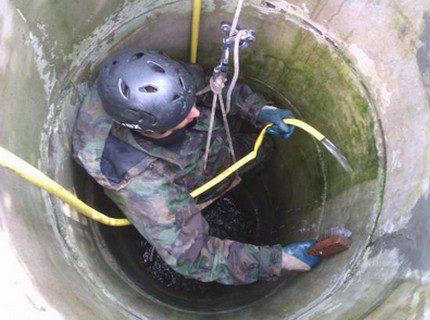
The mechanical cleaning procedure includes several basic steps:
- Pumping water. Before performing mechanical cleaning, the structure is pre-emptied by pumping liquid out with a drain pump. Keep in mind that it will not be possible to completely drain the well shaft, a small amount of water will still remain at the bottom.
- Cleaning the walls and bottom. The worker performing the cleaning, dressed in a protective suit, descends into the well. The helper stays on the surface and takes in filled buckets. Debris and sludge residues are removed manually using a wire brush or a regular scraper. Crushed stone and sand, covering the bottom of the structure and performing the function of the bottom filter, are replaced with a new one.
- Repair and strengthening of well rings. If necessary, in order to prevent the rings from shifting relative to each other, they are reinforced with metal brackets.
- Joint sealing. If cracks are found in the joints between the rings, the defects are sealed with cement mortar, to which water glass is added.
When replacing bottom filter instead of crushed stone, you can use natural sorbents such as shungite or zeolite. They not only mineralize water, but also protect it well from heavy metals and petroleum products. The thickness of the newly lined layer should be at least 15 cm.
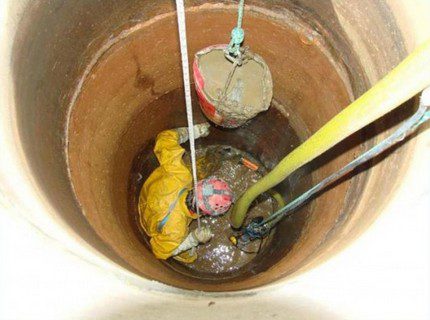
Disinfection
Disinfection of water is carried out after mechanical cleaning and eliminate leaks in the joints. It is performed by applying the solution to the walls of the structure with a fur roller or a wide brush. For this purpose, use bleach.
To prepare a 2% solution, bleach is diluted with water per 1 liter of liquid, 20 g of powder. When using pure chlorine, a solution of the required concentration is obtained by diluting the powder at the rate of 3-5 g per 1 liter of water.
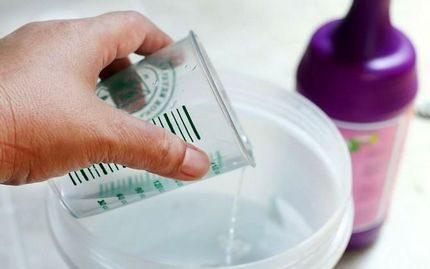
The prepared solution is insisted for 1-2 hours in a container under a tightly closed lid. The settled mixture is poured into another container. The upper layer that has risen to the surface is used for disinfection.
Disinfection of a well using chlorine is performed in the following sequence:
- A diluted 2% solution with a wide brush or roller is applied to the inner walls of the well, covering them evenly over the entire surface. The remainder of the drug is treated with a bottom filter.
- After applying the product, the well is filled with water. A new portion of the solution is added to the poured water, but it is already prepared in a ratio of 1: 5.
- The solution, poured into the well, is thoroughly mixed with a long pole or by alternately scooping up liquid with a bucket, followed by pouring it back.
- The mouth of the well treated and filled with water is covered with a plastic wrap and left for a day. This is necessary because chlorine has the ability to quickly evaporate. In order for chlorine to give the desired effect, it is important to keep the mine cool.
- After waiting 24 hours, the chlorinated water is pumped out of the well and waiting for it to fill. The next day, the disinfection procedure is repeated.
One cubic meter on average takes 500 g of solution.

Purified water must not be used. Before putting the facility into operation, the well will have to be emptied and wait for it to be filled “from scratch”. If, after filling, the smell of chlorine is present in the water, it will have to be repeated. Within 5-7 days after completion of chlorination, the water is boiled.
If we consider other available means, then the disinfection of the structure can also be performed using the same potassium permanganate. For this, potassium permanganate is diluted in water at the rate of 1 teaspoon of powder per 10 liters of liquid. The solution is poured into a mine with water.
After waiting a day, empty the well and wait until it is filled again. After cleaning, a small bag, sewn from synthetic fabric and filled with potassium permanganate, is lowered into the shaft. It should be left in the well on an ongoing basis.
On sale there are also special chlorine-containing preparations such as “Aquatabs”, “Septolit-DCC”, “Ecobriz-Oxy”. They are available in liquid, powder or tablet form.
Based on these concentrates, in accordance with the instructions, dilute disinfecting solutions are used using the same technology as when working with bleach.Any of these products improves water quality and extends the life of the structure.
The use of dosing cartridges
In the case of severe water pollution, when simple cleaning methods do not give the desired result, experts recommend using more radical measures - use dosing cartridges.
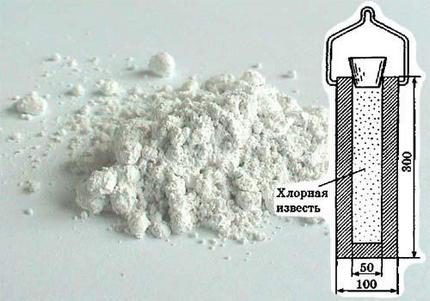
Cartridge body from 250 to 1000 cm3, made of ceramic, the porous walls of which freely pass active chlorine into water. The amount of cartridges required for disinfection depends on the volume of water in the mine and the degree of contamination.
Disinfection using dosing cartridges should be carried out under the supervision of SES workers, while monitoring water quality relative to microbiological and sanitary-chemical indicators.
The tanks are suspended in the well shaft, immersed in the water column and placed at a height of 20 to 50 cm from the surface of the bottom filter. Monitoring the concentration of the active substance in water is carried out after 6 hours from the moment of immersion of the cartridge. It should be 0.5 mg / L. If the indicators are lower than necessary, another cartridge is buried.
Subsequently, concentration control is performed every seven days. Cartridges are replaced every 3-4 weeks.
Alternative UV Cleaning Method
Disinfection of the contents of the well can also be done by irradiating it with ultraviolet light. This method is less time consuming, but more expensive. Ultraviolet disinfection is performed only after preliminary mechanical cleaning.
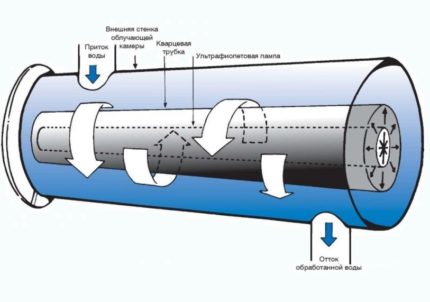
UV rays, the wavelength range of which is 200-295 Nm, can destroy pathogenic microorganisms. The higher the radiation dose, the less time it takes to disinfect the contents of the mine. For the destruction of most pathogenic bacteria, a radiation dose of 15 mJ / cm² is sufficient.
The main advantage of water purification by irradiation with ultraviolet is that it does not cause a change in the taste of drinking water.
Water pollution prevention
Cleaning and disinfecting water in a well requires a lot of time and effort. In order to minimize the occurrence of this kind of trouble in the future, do not forget to carry out preventive disinfection measures.
Compliance with a number of simple rules will help prevent water pollution in the well:
- At hydraulic structure take care of the clay castle. To do this, dig a trench around the well with a width of 1.5-2 meters and a depth of 50 -100 cm. It must be covered with clay and rammed tightly. A built clay castle will simultaneously perform two functions: to prevent the penetration of moisture and to prevent contamination of the structure through the seams between the rings.
- When arranging the bottom filter, use flint gravel, which has the property of softening water, or zeolite, which acts as a natural sorbent.
- Equip the well head with a lid or canopy. They will not allow dust and small debris to enter the mine, and will also protect well water from direct sunlight.
- To reduce the risk of leaks during the operation of a hydraulic structure, use stations with external ejectors and submersible pumps.
Proper arrangement of the water source will eliminate the need for frequent disinfection.
If your summer cottage does not yet have its own source of water and you have not decided on its type, we recommend that you read the information in the article comparing well and wellevaluating the pros and cons of both options.
Conclusions and useful video on the topic
Video review of a tablet disinfectant Aquabriz:
Video presentation of a lamp for an ultraviolet disinfection system:
Do not wait for thunder from a clear sky. After all, water is what we use daily. And therefore it is so important to be sure that it does not contain harmful substances. To protect yourself and your loved ones, do not neglect the rules of operation and regularly check the composition of the water even if it seems crystal clear.
We are waiting for your stories about self-cleaning and disinfection of well water. Please write in the comment box. Ask questions, share impressions, useful information and thematic photos here.

 How to find water for a well: an overview of the most effective ways to find water on a site
How to find water for a well: an overview of the most effective ways to find water on a site 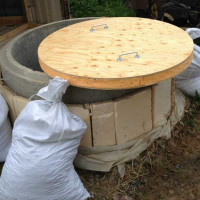 Do-it-yourself well warming for the winter: an overview of the best materials and methods of warming
Do-it-yourself well warming for the winter: an overview of the best materials and methods of warming 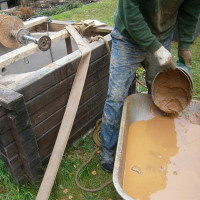 Do-it-yourself well cleaning: a review of the best preventative and capital methods
Do-it-yourself well cleaning: a review of the best preventative and capital methods 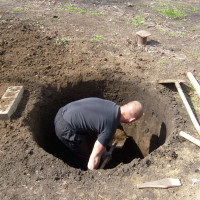 Digging a well with your own hands: types of well structures + an overview of the best digging technologies
Digging a well with your own hands: types of well structures + an overview of the best digging technologies 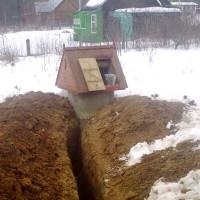 Winter water supply from a well: an overview of the best options and arrangement schemes
Winter water supply from a well: an overview of the best options and arrangement schemes 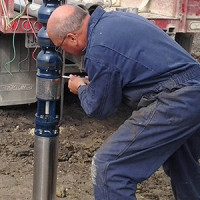 Self-repair of a well: an overview of the best methods of restoration and resuscitation
Self-repair of a well: an overview of the best methods of restoration and resuscitation  How much does it cost to connect gas to a private house: the price of organizing gas supply
How much does it cost to connect gas to a private house: the price of organizing gas supply  The best washing machines with dryer: model rating and customer tips
The best washing machines with dryer: model rating and customer tips  What is the color temperature of light and the nuances of choosing the temperature of the lamps to suit your needs
What is the color temperature of light and the nuances of choosing the temperature of the lamps to suit your needs  Replacement of a geyser in an apartment: replacement paperwork + basic norms and requirements
Replacement of a geyser in an apartment: replacement paperwork + basic norms and requirements
Last summer, a well was being cleaned at the father's house. The water had an unpleasant aftertaste and the color became not so transparent.
I wanted to say that cleaning a well is a difficult and time-consuming job. The problem was pumping water: although the bottom was covered with silt and mud, pumped volumes quickly resumed in the well trunk. Dirt pulled decently, ten buckets. I also had to tinker with the sludge on the walls, sorted out and washed the bottom filter.
The result was not long in coming! After a couple of days, the taste of the water improved and turbidity no longer manifested.
I think that cleaning the well is necessary once every five to seven years, provided that the well is well covered and closed from direct ingress of dust and rainwater. No super purified drinking water can be compared with well water from a pure source!
I have a well on the site. To avoid pollution of water from the outside, I updated the above-ground part made by the log house and close it with a lid. Reinforced concrete rings sometimes turn green and so that the water does not deteriorate, we clean the walls of the well with a neighbor. I take a stiff brush, I go down the walls. I usually do this in the middle of summer, when there is not much water. If there is a lot of water, then I first pump it out. Typically, cleaning lasts for a year.
To clean a well every year is overkill. Even by standards, if I remember correctly, this is done every two years.